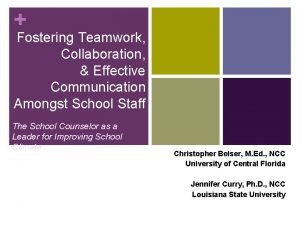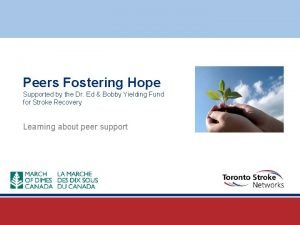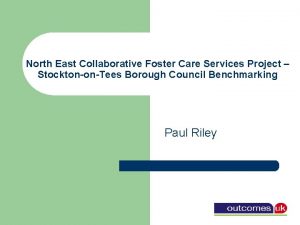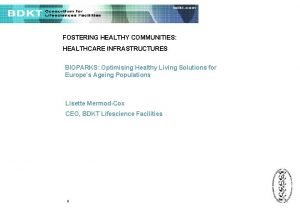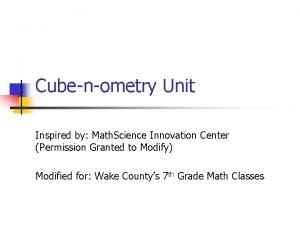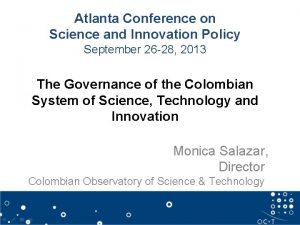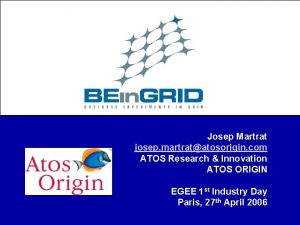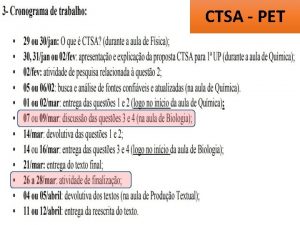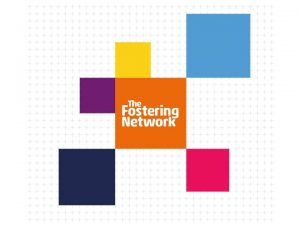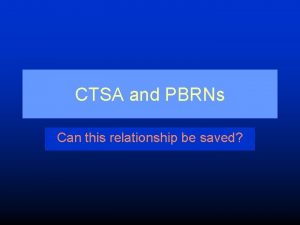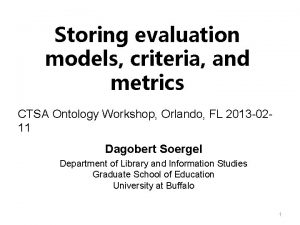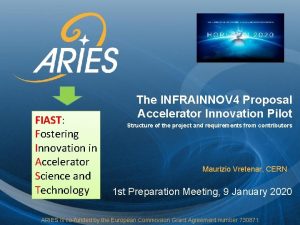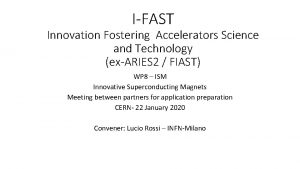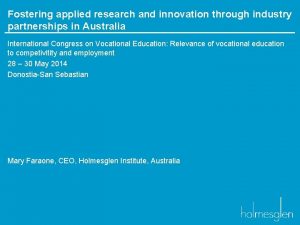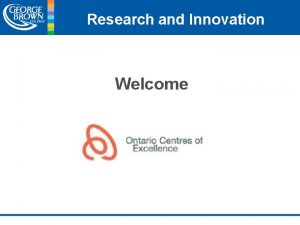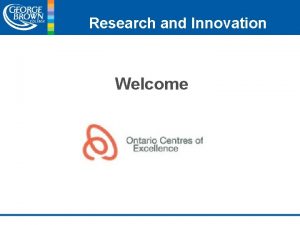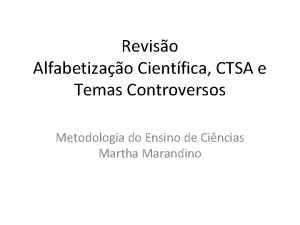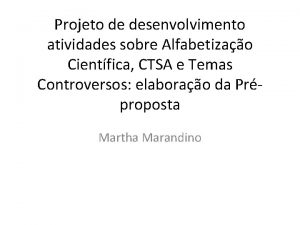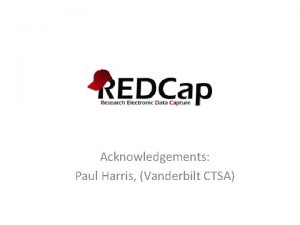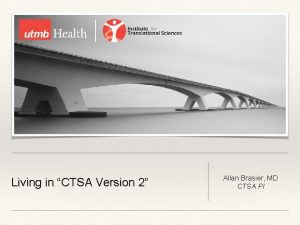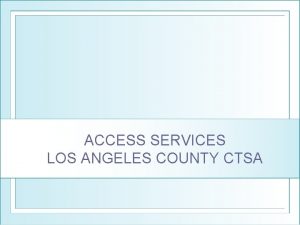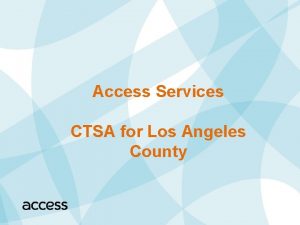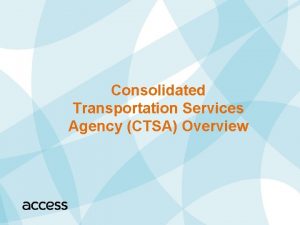The CTSA Fostering Team Science and Research Innovation
























































- Slides: 56

The CTSA: Fostering Team Science and Research Innovation

CTSA • What is it? • Purpose/Intent • Why & How did they come to be? • Condu. ITS: CTSA at ISMMS • Impact

Clinical and Translational Science Award (CTSA): what is it? • An NIH infrastructure grant in support of a matrixed CT research enterprise, designed to accelerate the ability to harness the promise of discovery science to solve problems of human health in impactful ways & to speed bench to bedside translation of scientific discoveries • A funding vehicle to support health improvements for society at large through innovative transdiciplinary research programs & partnerships


CTSA Program: Purpose • To develop innovative solutions that will improve the efficiency, quality and impact of the process for turning observations in the laboratory, clinic and community into interventions that improve the health of individuals” and populations at large* • To provide added value to interconnect, enrich advance, foster cross talk and weave together the tapestry of diverse scientific disciplines and medicine to solve complex problems in human health * NCATS definition

CTSA Purpose • To reengineer & transform the research enterprise – Move from a Siloed to a Systems Biology/Social Network structure to

CTSA Program • Establish novel initiatives which focus on efforts that are essential to accelerate basic research discoveries and speed translation of these discoveries into clinical practice as well as explicitly address roadblocks that slow the pace of medical research in improving the health and well being of society

CTSA Key Research Elements • Translational • Innovation • Transdisciplinary • Communities of Practice (Co. P) Team Science

Innovation • Definition: – The process of translating an idea or invention into a good or service(s) that creates value for others and satisfies a specific need – The deliberate application of information, imagination, or initiative in deriving different values from resources & includes a processes by which new ideas are generated and converted into useful products, tools, applications

Types of Innovation* • Evolutionary – Continuous or dynamic evolutionary innovation that are brought about by meaningful incremental advances in technology or processes • Revolutionary – Also called discontinuous, which are also disruptive and new * Taken from the Business dictionary

Revolutionary Innovation


CTSA • What is it? • Purpose/Intent • Why & How did they come to be? • Condu. ITS: CTSA at ISMMS • Impact

Harnessing Data in the Information Age

Landscape of Biomedical Science From Solitary to Team Framework

Origin of the CTSA NIH Directors Panel of Experts: POR CTSA Version 1 NCRR Recommendations 1995 KL 2 & TL 1 Programs 2006 K 30, Mentored K 23, Health Services KO 8, KO 7, K 24 Road. Map T 32 * K 12 2005 NCI LLM PRG 2000/2001 C-TRAC NIH Road. Map 2004 CTSA Version 2 NCAT 2012 CTSA Version 3 Current RFA

Cancer Translational Research Allied Consortium (C-TRAC) • Shorten drug development from 5 -10 yrs to 2 yrs • Comprised of nationally designated centers for translational cancer research that are affiliated with academic institutions • C-TRAC centers will fulfill well defined criteria and compete for designation

C-TRAC: a precursor for CTSA Blueprint • Governed by National Leadership Group & Board • Proposed Responsibilities: Drug discovery, validation & Identification of lead compounds Biomarker discovery Preparing clinical grade reagents & Conducting phase I/II Managing intellectual property and tech transfer issues Developing sustainable models for career paths in translational investigation – Providing training & mentorship for development of new translational investigators – Developing and maintaining cores to support the myriad needs of translational researchers – – –

Origin of the CTSA NIH Directors Panel of Experts: POR CTSA Version 1 NCRR Recommendations 1995 KL 2 & TL 1 Programs 2006 K 30, Mentored K 23, Health Services KO 8, KO 7, K 24 Road. Map T 32 * K 12 2005 NCI LLM PRG 2000/2001 C-TRAC NIH Road. Map 2004 CTSA Version 2 NCAT 2012 CTSA Version 3 Current RFA

NIH Road. Map • Transform the way Biomedical Research is conducted • High Risk/High Reward • Enable the development of transformative tools & methodologies • Address fundamental knowledge gaps – Not possible by one NIH Institute alone • Change academic culture to foster collaboration & team science


Three Themes • New Pathways to Discovery • Clinical Research Enterprise • Research Teams of the Future – Transdisciplinary

Spectrum of Collaborative Research • • Disciplinary Multidisciplinary Interdisciplinary Transdisciplinary 6/14/2010 JL Gabrilove

Multidisciplinary • Research in which different fields of expertise are brought to bear on a given question without integration • Research which brings a new angle or different perspective from varied unique disciplines • Disciplines investigating research themes using their own approaches • Retention of disciplinary autonomy 6/14/2010 JL Gabrilove

Interdisciplinary • A field of study that crosses traditional boundaries of academic disciplines or schools of thought • Common framework within which distinct epistemological approaches are utilized • Shared problem formulation 6/14/2010 JL Gabrilove

Transdisciplinary Research • Interpenetration, integration or fusion of disciplinary methodologies • Collaborative knowledge generation • Intentional involvement of stakeholders in the definition of the problem. • Engagement with spheres of practice 6/14/2010 JL Gabrilove

Transdisciplinary Research 1 • Transcends well established and familiar boundaries of traditional disciplines • Complementary to ongoing discipline focused research • Implies the invention of “new science” at the intersection of respective fields • “Theoretical, conceptual and methodological reorientation with respect to core concepts of participating disciplines” 2 6/14/2010 JL Gabrilove 1 Gray, B; Amer J Prev Med 2008; 35 (2 S): S 124 -132 J. EOLOSS Publishers Ltd, 2000 2 Mc. Michael

Examples of Transdisciplinary Research • • Bioinformatics & Computational Biology Ethnography Systems Biology Environmental Science Social Media & Networking Integrative Medicine Global Health Personalized Medicine 6/14/2010 JL Gabrilove

Examples of Transdisciplinary Research • • Bioinformatics & Computational Biology Ethnography Systems Biology Environmental Science Social Media & Networking Integrative Medicine Global Health Personalized Medicine 6/14/2010 JL Gabrilove

Funding for the Road. Map Initiatives • NIH Institutes & Centers contributed to a common pool of resources and a plan as to how these resources would be utilized • Administered centrally • implemented by Working Groups composed of staff from multiple NIH Institutes or Centers • Institutionalized a corporate process for decisionmaking about priorities that span the breadth of the NIH. • NIH Reform Act (2006) provided continued support for Roadmap programs through the NIH Common Fund



Origin of the CTSA NIH Directors Panel of Experts: POR CTSA Version 1 NCRR Recommendations 1995 KL 2 & TL 1 Programs 2006 K 30, Mentored K 23, Health Services KO 8, KO 7, K 24 Road. Map T 32 * K 12 2005 NCI LLM PRG 2000/2001 C-TRAC NIH Road. Map 2004 CTSA Version 2 NCAT 2012 CTSA Version 3 Current RFA



Transdisciplinary C/T Investigator: Characteristics & Skill Set • • • Critical Thinking Ability to think outside the box Openess to New Ideas, Technologies & Approaches Imaginative Adept at language: multi-lingual – Acquisition of new vocabulary • Ability to move outside comfort zone • Expertise in specific domain & “Informed Consumer” in other arenas


Challenges 1 • Operationalizing cross disciplinary team science and training more clearly • Conceptualizing the multiple dimensions of readiness for team science • Ensuring sustainability of transdisciplinary team science • Creating and validating improved models, methods & measures for evaluating team science • Fostering a culture that values, promotes and rewards equitable research contributions and collective leadership/authorship 1 Hall, KL et al, Am J Prev Med 2008; 35 (2 S) S 243 -249

The Basic and Clinical Science Cultural Divide • Basic Science – Never arrive before 10 – Devise experiments to test hypotheses – Theoretical knowledge – Contemplating data – Duplication of Data – Operating system X – Unit of measure: RO 1 – Quantitative measures 6/14/2010 JL Gabrilove • Clinical Science – Early risers – Informed by experiments of nature – Practical knowledge – Acting on evidence – Unique cases: N of 1 – Operating system Y – Unit of measure: RVU – Qualitative measures



Condu. ITS: Institute for Translational Sciences Key Principles • • • Transformative Catalytic Additive & Synergistic Cross Cutting Unique Added Value Key Elements* • Informatics – Query tools: I 2 B 2 • Workforce Development – Mentored CTS Training • Research Expertise, Methods & Processes – BERD • Community Engagement • Investigation across the Lifespan *resources & platforms

Clinical & Translational Science (CTS) Education: Goals • Mentored To Independent Training Initiatives: • NRSA TL 1 New Entry PORTAL (pre-doc) and STTEP-UP Training in Science and Medicine Initiative (post-doc) • KL 2 Scholars • Emerging Investigators Forum(s) • Specialized Training Opportunities & Resources Create or further extend and enrich specific mentored training opportunities for emerging pre-doctoral, post-doctoral and junior faculty CT Investigators, by means of: • Expanded novel offerings in our Clinical & Translational Science Education degree granting program

Mentored to Independent Investigator Early Training Award recipients: F 31/ F 31 Equivalent Awards (predoctoral) NRSA TL 1, T 32 Mentored Award Recipients: F 32, T 32, K & K Equivalent Independent: R or R equivalent: K 24 Midcareer Mentor Award


Funding* * Owens B. Mapping Biomedical Research in the USA. Lancet 2014; 384: 11 - 14

Federal Funding – NIH • currently > 30 Billion • 300, 000 researchers, 2500 universities, 6000 intramural investigators (10%) • 27 Institutes – NCI largest portion: 5 billion – Fogarty International Center (reducing disparities in global health): 65 million – National Center for Advancing Translational Sciences (NCATS) newest (2011) – Centers for Disease Control (CDC) – 6. 6 billion – Veterans Affairs (VA) Office of Research & Development: 1. 2 billion • Health issues related to veterans (mental health, post traumatic stress, prosthetics, brain and spinal cord injury) – – – National Science Foundation (NSF): 7 Billion Department of Defense (Do. D): ). 5 billion NASA’s Human Research Program: 150 million US Department of Agriculture Department of Energy (Do. E): 300 million (5 billion budget) on biological systems • Home of the human genome project • 2/3 of budget goes to genomic research • Joint Genome Institute (JGI) *Owens B. Mapping Biomedical Research in the USA. Lancet 2014; 384: 11 - 14

Non-Federal Funding* • • • State-specific Private Foundations Drug & Device Industry Venture Capital Angel Investor(s) *Owens B. Mapping Biomedical Research in the USA. Lancet 2014; 384: 11 - 14

Other Funding • Loan Repayment Program – https: //www. lrp. nih. gov/ • Diversity Supplements – https: //www. nimhd. nih. gov/programs/extramural /training-career-dev/researchsupplements/diversity-supplements. html


Office of Research Infrastructure Programs (ORIP) Strategic Plan High priority trans NIH thematic areas are: • Developing models of human diseases. • Accelerating research discoveries by providing accessto state-of-the-art instrumentation. • Training and diversifying the biomedical workforce.

Management Essentials for the Emerging/Early Investigator* • Mentorship • Scientific Career Development – CATs toolkit (resources and support for investigators); IDP, Mentorship & being effective mentee; time management & prioritization; presentation skills; communicating with program officers; RCR; research ethics; communication in science • Grant Writing, grant management & principals of project management – Funding sources, agencies & opportunities; writing specific aims; career development awards; budgets and budget justification; understanding NIH peer review; pre-award and post award management • Leadership – Leading from self; understanding conflict; negotiation essentials: asking for what you need; collaboration essentials & teaming * Adapted from Byington et al, Acad Med 2016

Matrix Mentoring Model* Senior Scientific Self Staff Peer/Near Peer Byington CL et al. Acad Med. 2016; 91: 497– 502.

IDP: Guiding Mentee Career Development* * Martina CA, Gabrilove J, Luban N, Patino-Sutton C. JCTS 2018; 1, S 1: 2502

Institutional Resources to Support Research • • Center for Biostatistics & BERD GARC (grant application resource center) IRB ORS – IND & IDE consultation; Research Match; recrutiemtn methods; Clinical. Trials. gov • • • Sinai APPLab Sinai Biodesign Research Portal – SPIN: funding opportuntities – Grants application resource center – Protocol wizard to guide protocol requirements • • • PEAK – IDEATE & Infoed Training; other training modules of relevance to research Red. Cap including survey building & e. CRFs Research IT – IDEATE – Ideate@mssm. edu ; ideate support – Jean Davis administrator

New WEbsites http: //researchroadmap. mssm. edu/rrm/ http: //labs. icahn. mssm. edu/earlyinvestigators/
 Creativity and play fostering creativity
Creativity and play fostering creativity Fostering teamwork
Fostering teamwork Besigheidsplan
Besigheidsplan Disruptive and radical innovation
Disruptive and radical innovation Fostering hope scholarship
Fostering hope scholarship Fostering stockton on tees
Fostering stockton on tees Fostering healthy solutions
Fostering healthy solutions Fostering in doncaster
Fostering in doncaster My favourite subject english
My favourite subject english Math and science innovation center
Math and science innovation center Atlanta conference on science and innovation policy
Atlanta conference on science and innovation policy Martrat
Martrat Dg research and innovation
Dg research and innovation David provan safety
David provan safety Open innovation open science open to the world
Open innovation open science open to the world Bureaucratic bypass syndrome
Bureaucratic bypass syndrome Team spirit becomes team infatuation
Team spirit becomes team infatuation The white team cheers for the blue team, just like
The white team cheers for the blue team, just like Rdi research development innovation
Rdi research development innovation Hát kết hợp bộ gõ cơ thể
Hát kết hợp bộ gõ cơ thể Bổ thể
Bổ thể Tỉ lệ cơ thể trẻ em
Tỉ lệ cơ thể trẻ em Chó sói
Chó sói Chụp phim tư thế worms-breton
Chụp phim tư thế worms-breton Alleluia hat len nguoi oi
Alleluia hat len nguoi oi Môn thể thao bắt đầu bằng từ chạy
Môn thể thao bắt đầu bằng từ chạy Thế nào là hệ số cao nhất
Thế nào là hệ số cao nhất Các châu lục và đại dương trên thế giới
Các châu lục và đại dương trên thế giới Cong thức tính động năng
Cong thức tính động năng Trời xanh đây là của chúng ta thể thơ
Trời xanh đây là của chúng ta thể thơ Cách giải mật thư tọa độ
Cách giải mật thư tọa độ Phép trừ bù
Phép trừ bù Phản ứng thế ankan
Phản ứng thế ankan Các châu lục và đại dương trên thế giới
Các châu lục và đại dương trên thế giới Thể thơ truyền thống
Thể thơ truyền thống Quá trình desamine hóa có thể tạo ra
Quá trình desamine hóa có thể tạo ra Một số thể thơ truyền thống
Một số thể thơ truyền thống Cái miệng nó xinh thế
Cái miệng nó xinh thế Vẽ hình chiếu vuông góc của vật thể sau
Vẽ hình chiếu vuông góc của vật thể sau Thế nào là sự mỏi cơ
Thế nào là sự mỏi cơ đặc điểm cơ thể của người tối cổ
đặc điểm cơ thể của người tối cổ Giọng cùng tên là
Giọng cùng tên là Vẽ hình chiếu đứng bằng cạnh của vật thể
Vẽ hình chiếu đứng bằng cạnh của vật thể Fecboak
Fecboak Thẻ vin
Thẻ vin đại từ thay thế
đại từ thay thế điện thế nghỉ
điện thế nghỉ Tư thế ngồi viết
Tư thế ngồi viết Diễn thế sinh thái là
Diễn thế sinh thái là Dot
Dot Số nguyên tố là
Số nguyên tố là Tư thế ngồi viết
Tư thế ngồi viết Lời thề hippocrates
Lời thề hippocrates Thiếu nhi thế giới liên hoan
Thiếu nhi thế giới liên hoan ưu thế lai là gì
ưu thế lai là gì Sự nuôi và dạy con của hổ
Sự nuôi và dạy con của hổ

